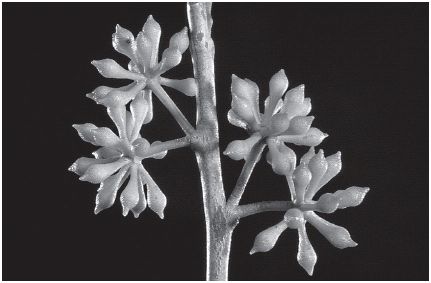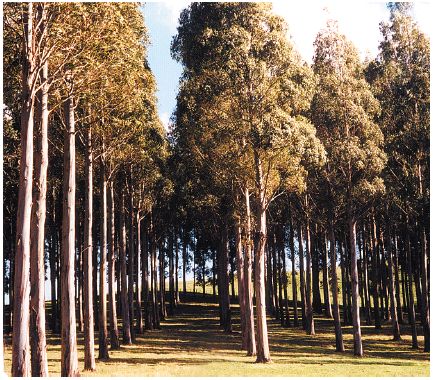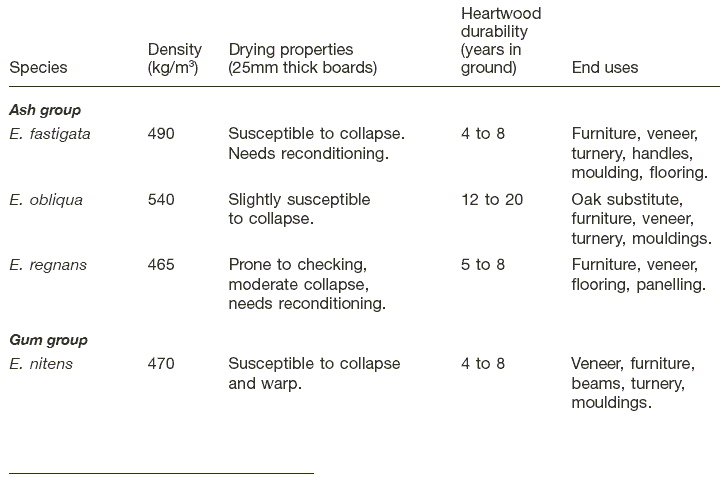Growing cold-climate eucalypts for high quality timber
NZFFA Information leaflet No. 17 (2005).
The eucalypts that grow in the cool moist montane forests of southeast Australia include a number of valuable timber species which will grow well in the cooler parts of New Zealand. These are mostly ash eucalypts, but E. nitens, a gum, is also in this category.
These species all produce a strong general purpose timber, noticeably stiffer, harder and heavier than pine, but not as heavy or as durable as the timber of eucalypts from warmer climates. Unless very large, logs often contain growth stresses which result in curved flitches when logs are broken down, and this may require re-sawing to get satisfactory lumber. The timber also needs care in air-drying to prevent or minimise collapse and internal checking. On the positive side, most species produce a pale decorative timber that can be readily stained to any colour, and suitable flitches produce excellent veneers.
All the species in this group are fast growing, and on suitable sites they can match or out-perform radiata pine in both height and diameter growth. However, like all eucalypts, individuals need plenty of room if they are to make rapid diameter growth, so stockings need to be relatively low for large diameter logs, and buttlog volume growth/ha of the final crop seldom matches that of radiata pine.
Species
E. fastigata often has relatively slow early growth, but it is a stayer, and capable of carrying higher volumes/ha than most other eucalypts. It will tolerate heavy soils of moderate fertility, and most provenances will tolerate frosts of -12°C. Open grown trees tend to be heavily branched, but because it will tolerate relatively close spacing, form in stands is generally good. Produces an excellent timber.

E. obliqua is somewhat similar to E. fastigata but there is wider provenance variation. Most provenances will not tolerate frosts of more than -10°C. Mainland Australian provenances produce a moderately durable timber similar to that of E. fastigata, but Tasmanian provenances produce timber similar to that of E. regnans. Usually coppices reliably.
E. regnans, E. delegatensis. Both are faster growing and usually of better form than the above, and prefer cooler moist sites with good drainage. E. regnans is quite variable in its frost tolerance, but the best provenances will tolerate -12°C, while E. delegatensis will tolerate -14°C. Both produce a pale decorative timber producing premium veneers, but logs require care in sawing because of growth stresses, and lumber requires great care in drying to minimise collapse and internal checking. Tasmanian provenances of E. delegatensis are relatively slow growing, but produce a stronger more stable timber.
E. fraxinoides will not usually tolerate frosts of more than -7°C, and it suffers badly from root rots unless sites have very good drainage. However, limited experience in New Zealand has shown that it saws very well, producing a timber similar to that of E. regnans.
E. nitens can be very fast growing, capable of reaching 80cm dbh in 20 years on good sites. It will tolerate frosts of -14°C, and heavy but not waterlogged soils, but requires good fertility for fast growth. Form is usually excellent, but provenances from central Victoria with persistent blue-grey juvenile foliage have the best form and fastest growth. Produces an excellent very pale veneer, but sawn timber is similar to that of E. delegatensis and requires similar care in seasoning.
Establishment
As a group, these eucalypts can readily be established using well-conditioned sturdy bare-rooted stock, but they do require good site preparation and weed control. If seedlings don’t get away to a fast start, they tend to sulk for many years, so it pays to plant them into soil which has cultivated by deep ripping, and to maintain weed control for a full year, preferably two on drier sites.
Because of their sensitivity to many weedicides, it is common to pre-plant spray using Permazol SDA or something similar e.g. Simazol and Roundup. Gardoprim at no more than 1.5 litres/ha can be used provided it is applied in September before shoot growth commences. It is normal to use a shield to protect the foliage when using post-plant sprays.
A handful of Diammonium phosphate (DAP) placed in a hole 15 to 20cm away from the plant soon after planting will also ensure that seedlings grow well the first year.
Silviculture
To grow these eucalypts with good even diameter growth to a size suitable for milling or veneering, final crop stockings should be around 100/ha, perhaps a few more where saw timber is the aim (E. fastigata, E. obliqua ) and a few less where veneer is the aim (E. nitens, E. regnans, E. delegatensis). Species and provenances with naturally good form require a selection ratio of about 3:1, but others require a selection ratio of at least 4 or 5:1 to get a satisfactory final crop. Bearing in mind that low initial stockings will result in shorter branchier trees, initial planting rates are usually 400 to 800sph.
Although these eucalypts will shed their smaller horizontal branches naturally, larger and more steeply angled branches will need to be pruned if the aim is to produce veneer logs or long clear lengths of lumber. Pruning should be done at the driest time of the year – mid to late summer – and should not exceed half the tree height if growth is not to be too greatly affected. Over-pruning will result in adventitious shoots sprouting later from the pruning wounds.
Thinning is critical, and should be carried out before crowns touch if diameter growth is to be maximised. As there is no market for thinnings, except as firewood, trees should be removed as soon as it is evident that they will not form part of, or have a beneficial influence on, the final crop.

A regime that has worked well for E. nitens being grown for veneer logs is as follows:
Age 1 and 2 Form prune the most vigorous 300sph to remove double leaders and steep-angled branches.
Age 3 to 4 Low prune the best 200sph when they are 5 to 6m tall, using a 6cm gauge, and thin out remaining stems.
Age 5 to 7 Extend the pruning annually, each year increasing the gauge size by 1cm (i.e. use a 7cm gauge for the 2nd pruning, 8cm for the third etc.) until there is a pruned butt of at least 6m. Pruning may be extended to 8 or 9m, but do not use ladders that grip the trunk with teeth, otherwise gum veins (kino) will form in the timber.
At each pruning, thin out the poorest 40 to 50sph until the stand is at final crop stocking.
E. nitens is usually faster growing than the other species, but the same principles of early pruning and heavy thinning still apply if the aim is to produce high quality butt logs.
Health
E. nitens can suffer severe attack by scale insects when young and when grown on warm, high-nitrogen sites.
The other species can suffer badly from leaf spot fungi when grown on warm sites, and they will also suffer from root rot if the drainage is at all impeded. Generally, however, these eucalypts remain very healthy when suitably sited.
For more detailed information, see Neil Barr’s book Growing eucalypt trees for milling, available from NZFFA.
Cold climate eucalypt processing and end use properties

Photographs reproduced from the August 1999, and May 2001 issues of the New Zealand Tree Grower.

 Farm Forestry New Zealand
Farm Forestry New Zealand